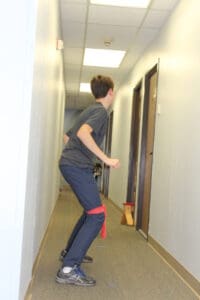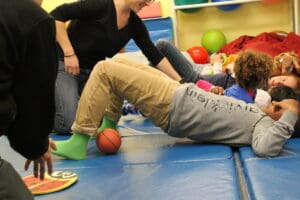One of the muscles we focus on when we are working with kids, or young adult (or even ourselves if we’re being honest) is the hip abductor, or the outer hip muscle. This muscle may be on the smaller side but it is mighty!
When this muscle is strong it helps to stabilize your hips for every day activities like walking, standing, running, climbing stairs, crawling, and on and on and on. If you have a strong hip abductor and you pick up your foot to take a step it will hold your hips level so that you have a nice smooth walking pattern. If your hip abductor is weak, it will not be able to keep your hips level and when you take a step a few things could happen. Two of the most common things are:
- when you pick your foot up, your hip on that side will drop down as compared to the hip on the other side, or
- when you pick your foot up, you will lean your head and trunk away from that foot so that you are creating a counter balance to help keep you stable.
So why is this a problem? Here are a few reasons:
- For a little one first learning to walk, if they don’t have the stability at their hips it makes it harder to take those independent steps and they will want to hold on to support surfaces longer
- For a little one first learning to crawl, they may have finally mastered getting on to their hands and knees, but they don’t have the stability to lift one of their legs to bring it forward, and every time they try they collapse back down on to their belly
- For someone who may have spasticity or higher muscle tone in their inner hip muscles (adductors), they may scissor their legs when they walk (cross them in the middle rather than stepping straight in front). If their abductors are strong they can help to counteract the scissoring pull and make walking a bit more efficient.
- For anyone working on running, your hips will do the same thing as with walking if its weak, except you are putting more stress on your knee with every step you run. This can lead to overuse injuries and knee problems that can cause pain and lead to limited physical activity.
So what can you do? Here are a few ideas for exercises:
- Sidestepping – depending on the age and skill of the child, this can look like cruising back and forth at a support surface, or it can be walking sideways down a hallway, or even adding resistance tubing/banding while walking sideways (make sure to lead with each foot)
- Bridging – depending on the age and skill of the child, this can look like lying on their back with their knees bent and their feet flat on the floor and having them lift up their bottom (you can make it fun by driving cars under the ‘bridge’ or rolling balls under), or it can be holding the bridge position for longer periods of time, or while you are in the bridge position lifting one foot off the ground and then the other, or just doing one leg bridges, or even adding a resistance band around your thighs to push against while doing two leg bridges
- Climbing – depending on the age and skill of the child, this can look like crawling up and down stairs (or couches), climbing on ladders at the park, using a climbing wall (even better is to traverse side ways on a climbing wall or park climbing structure)
What are some ways you have worked on the abductors?

